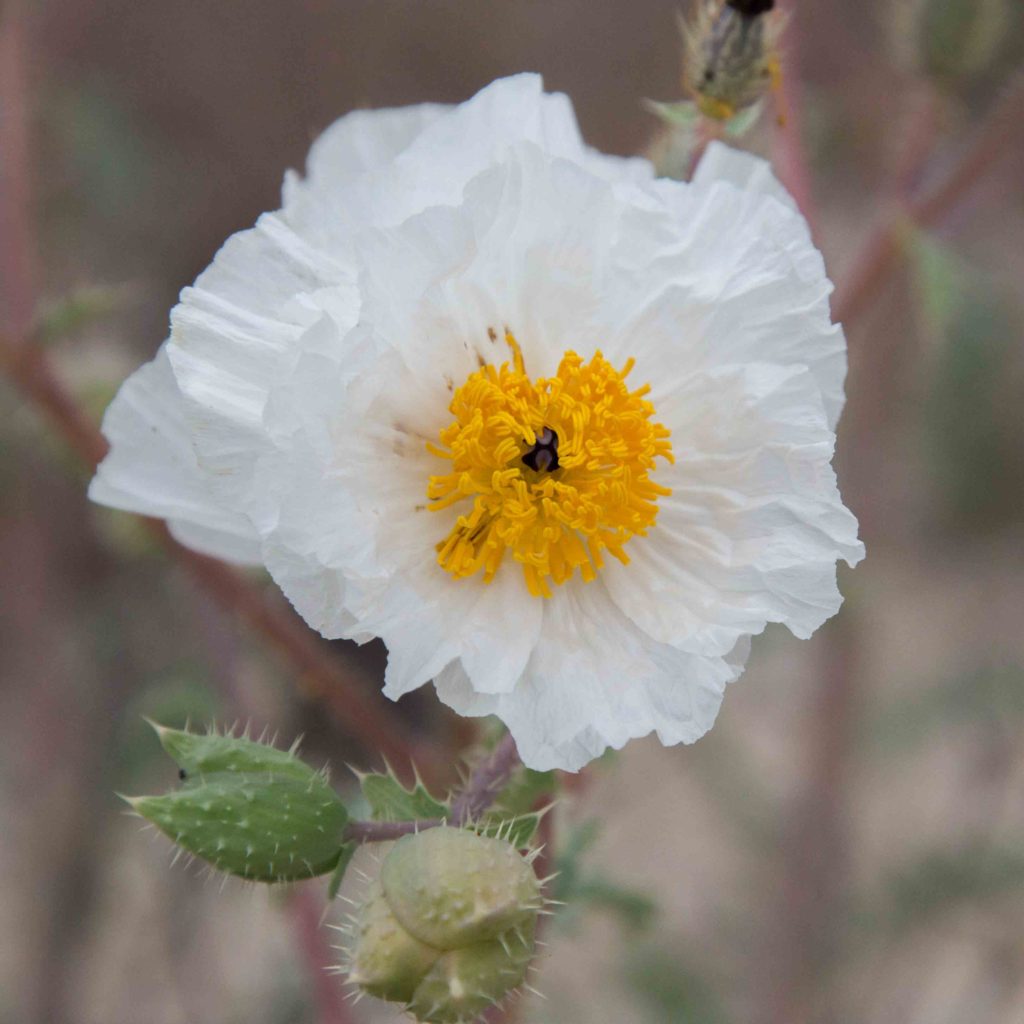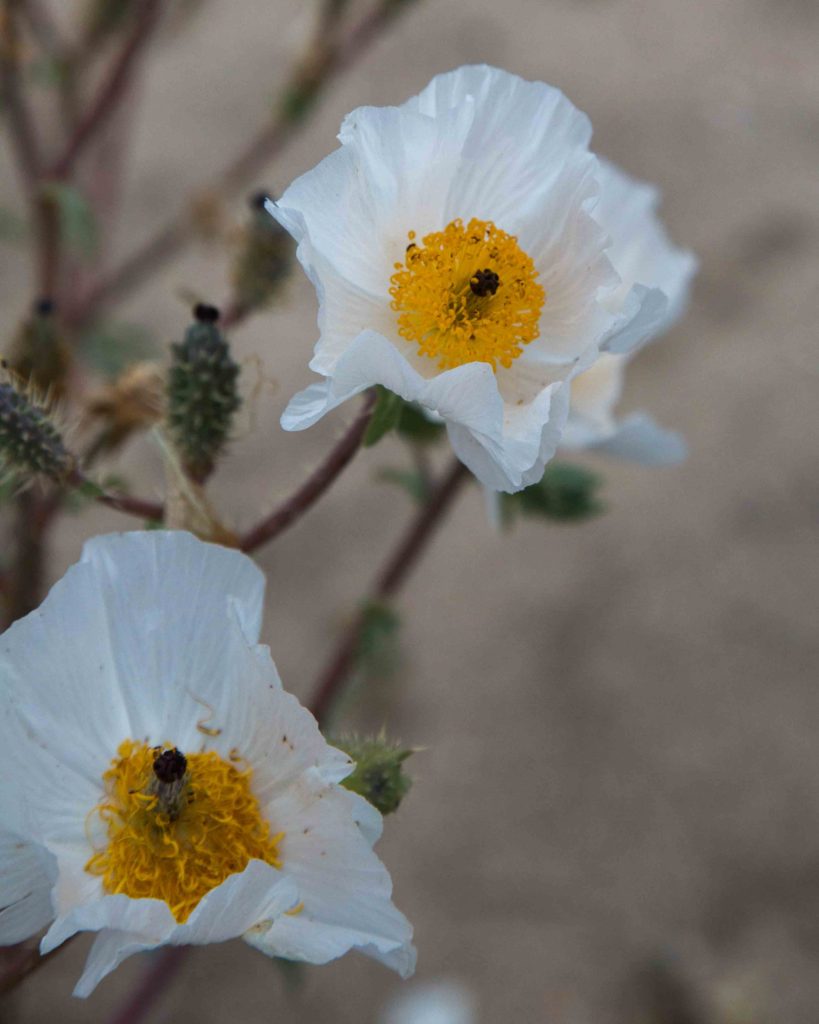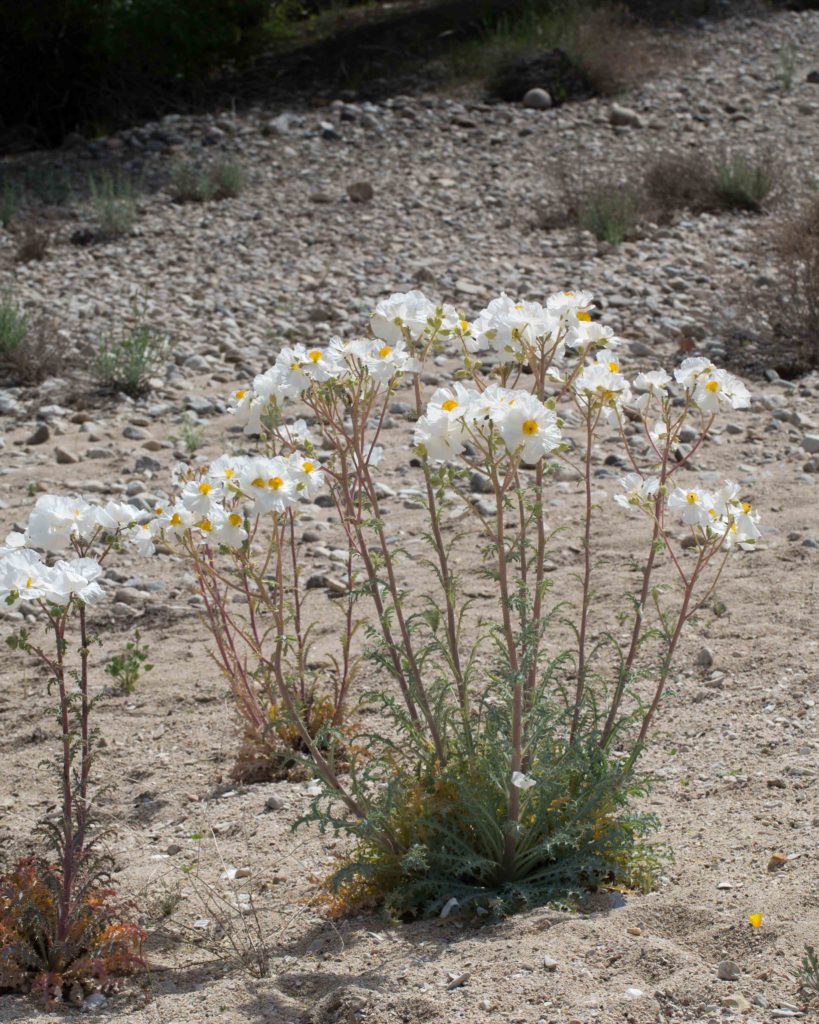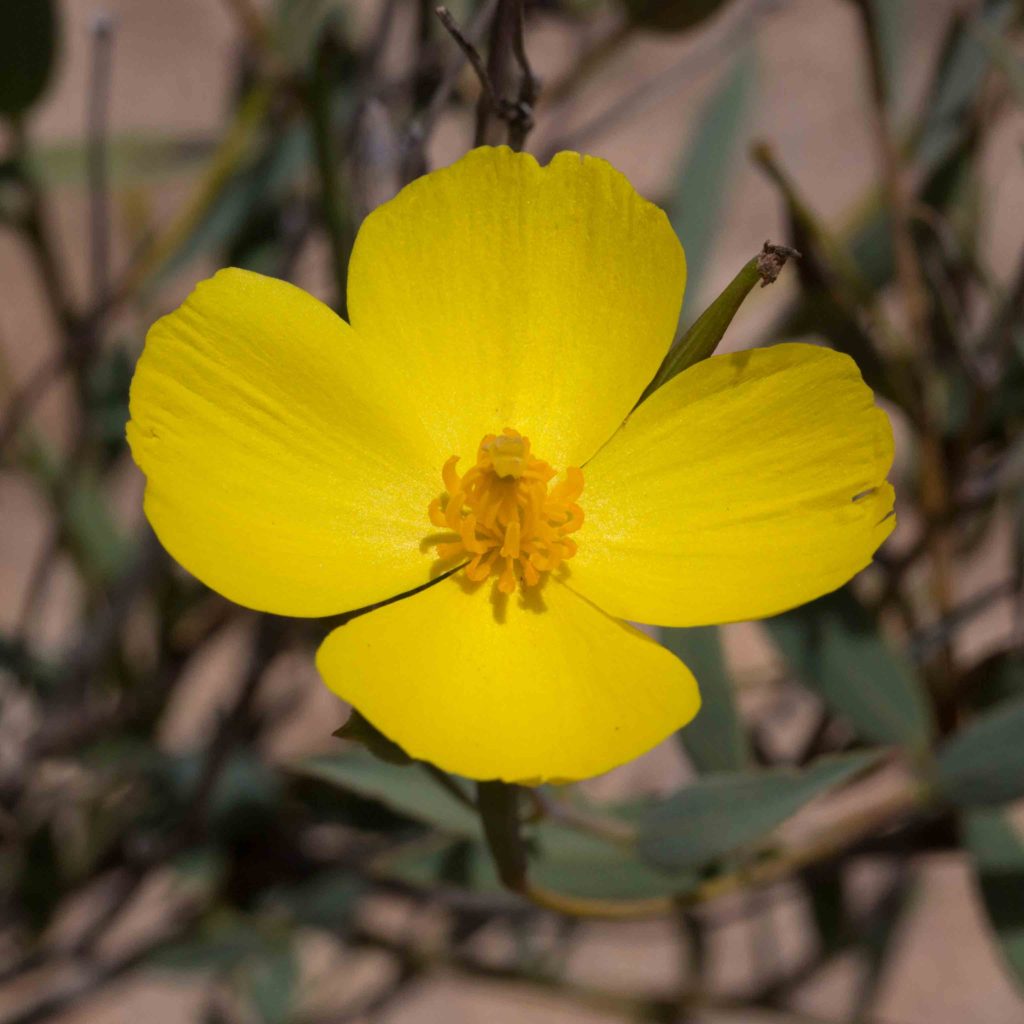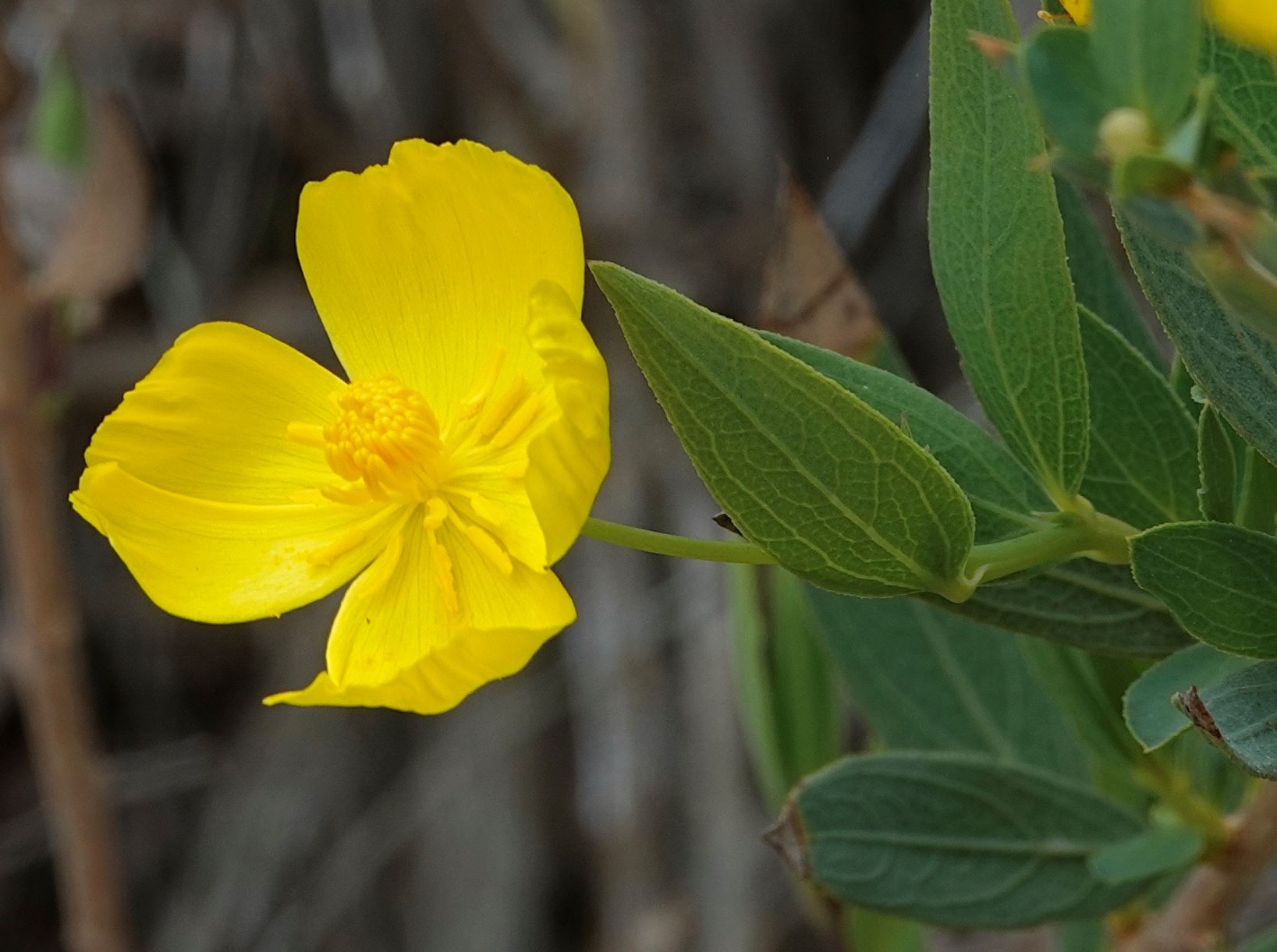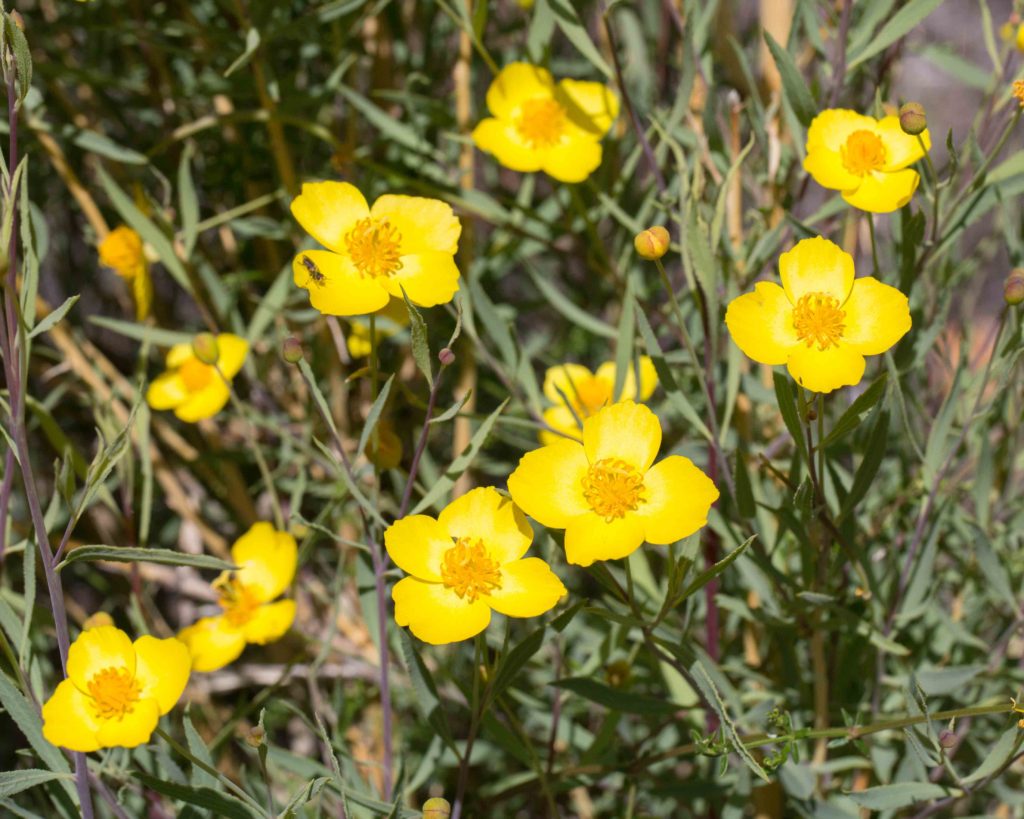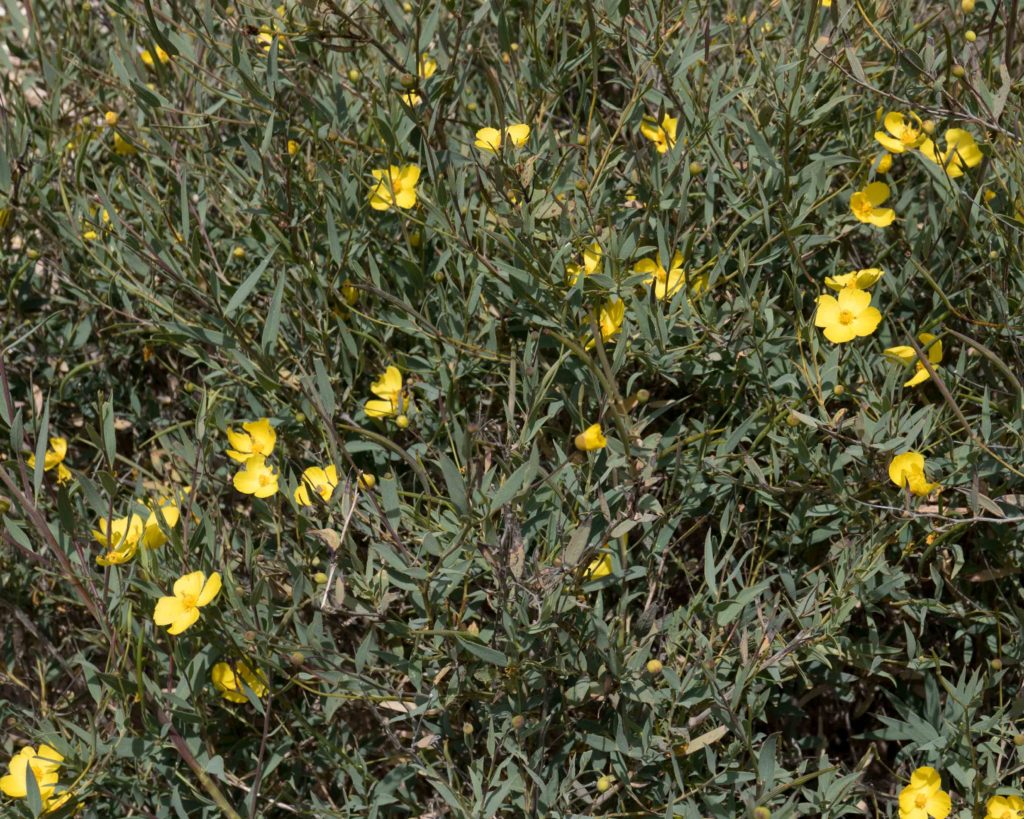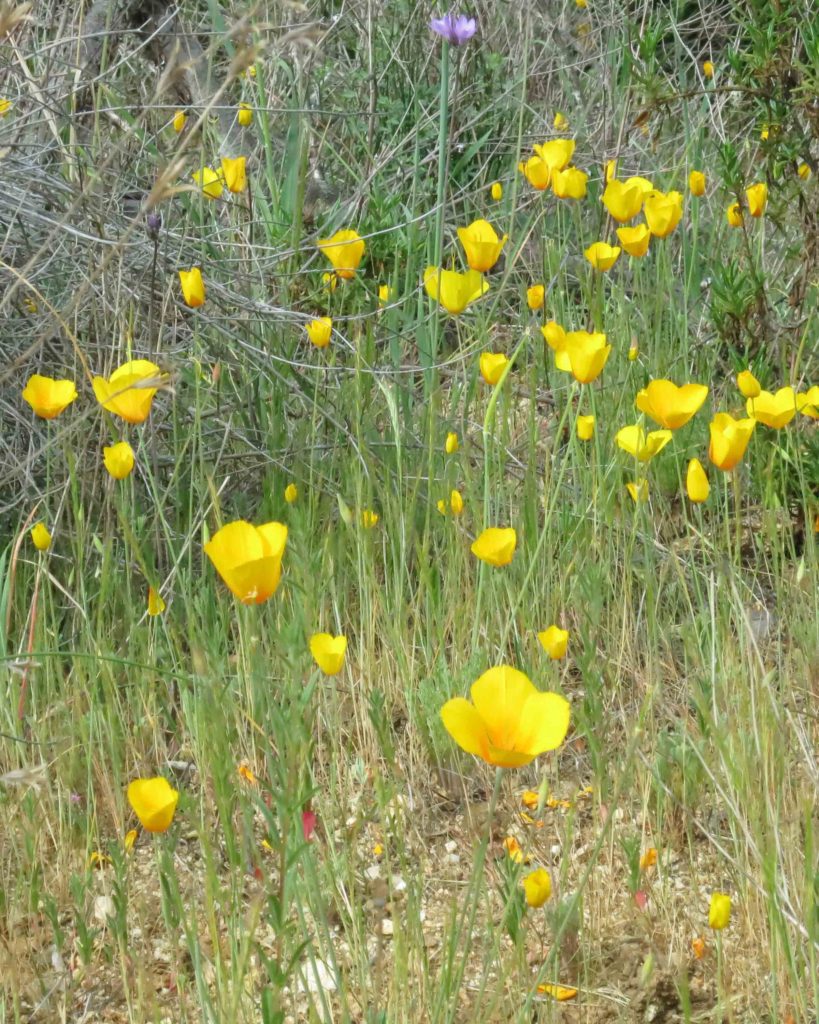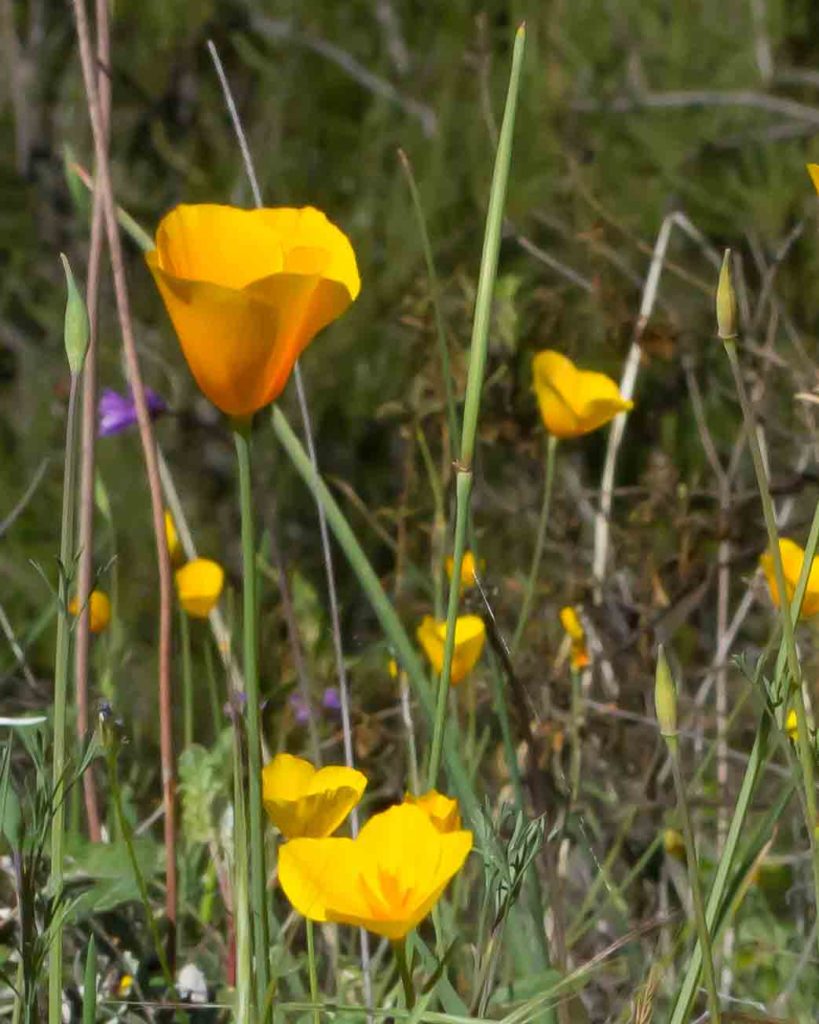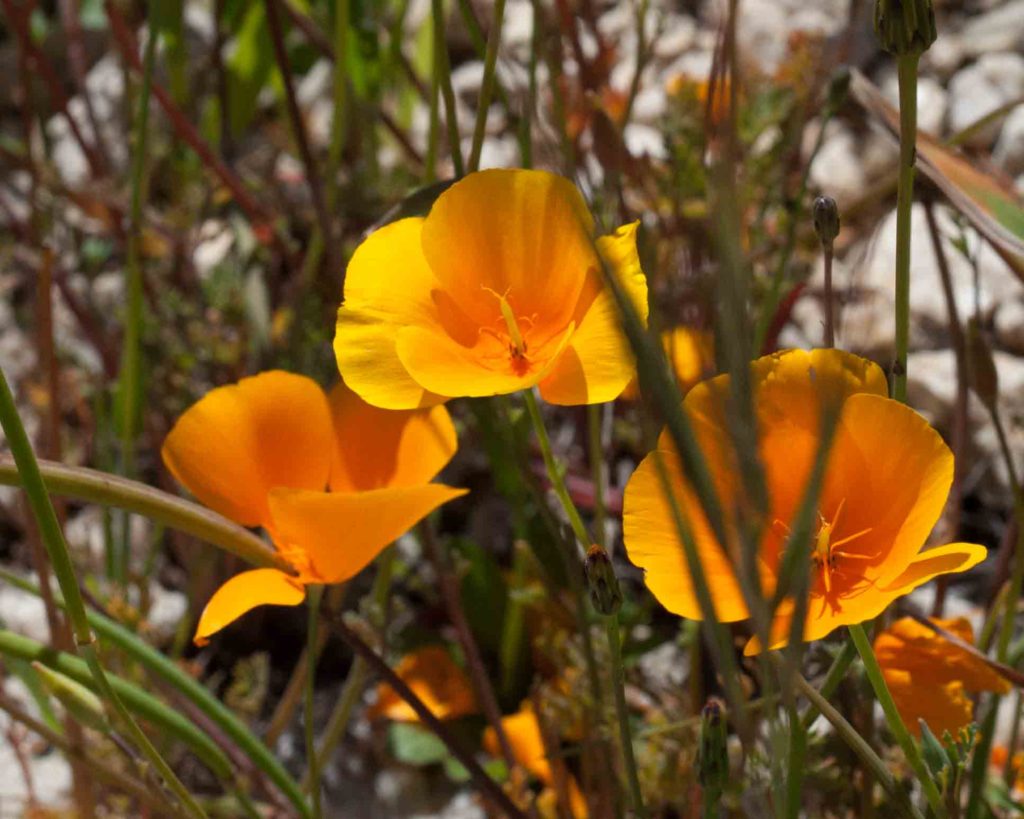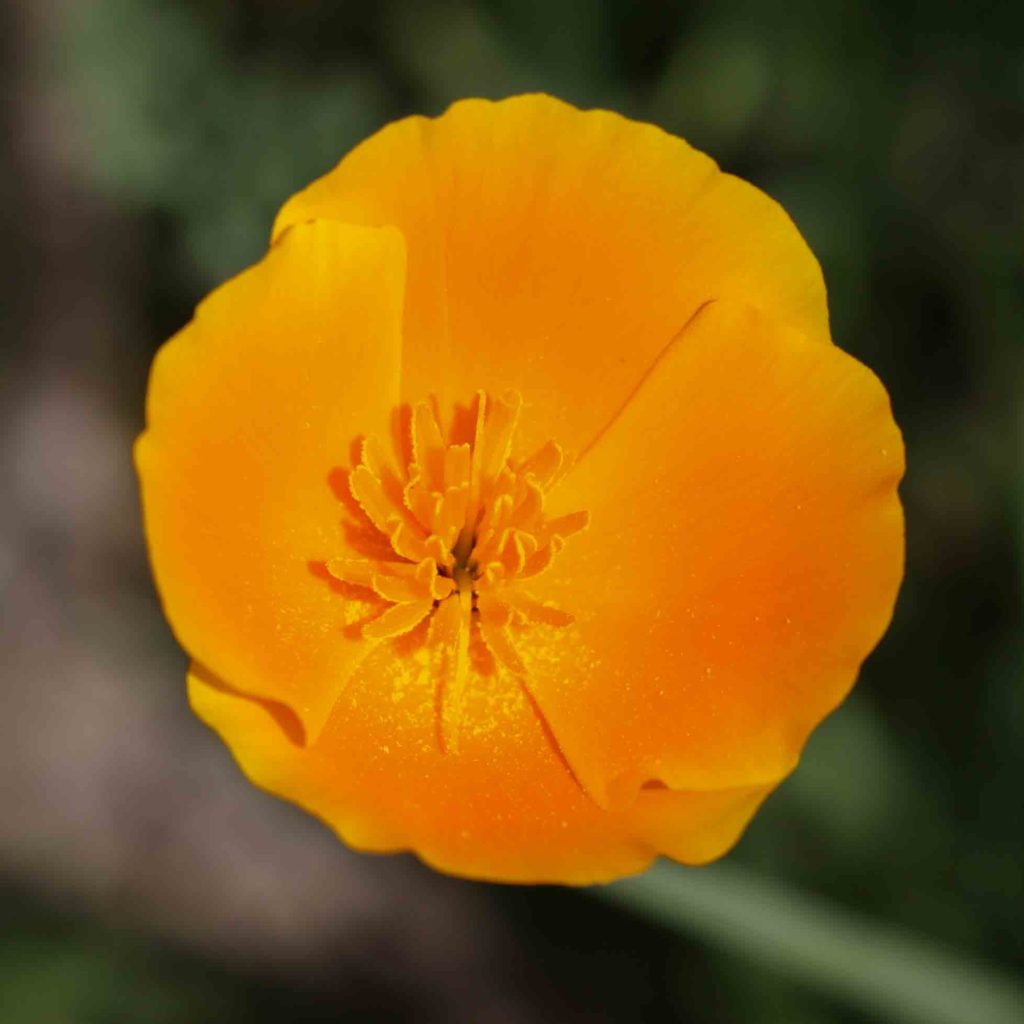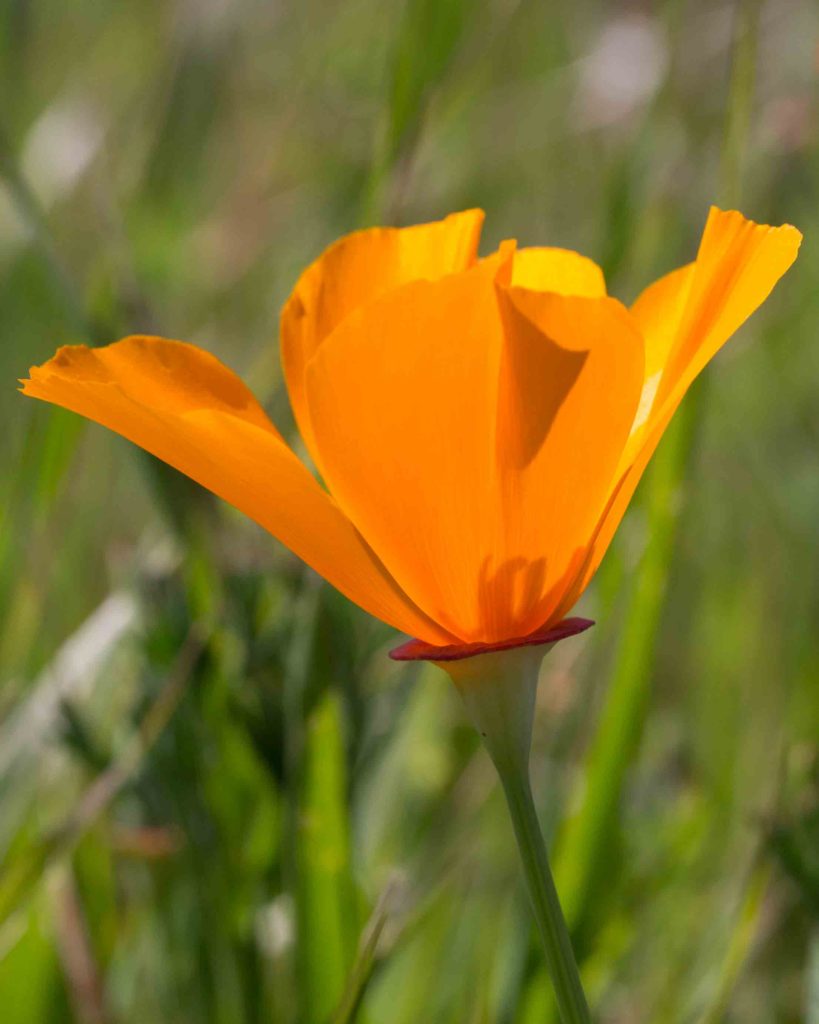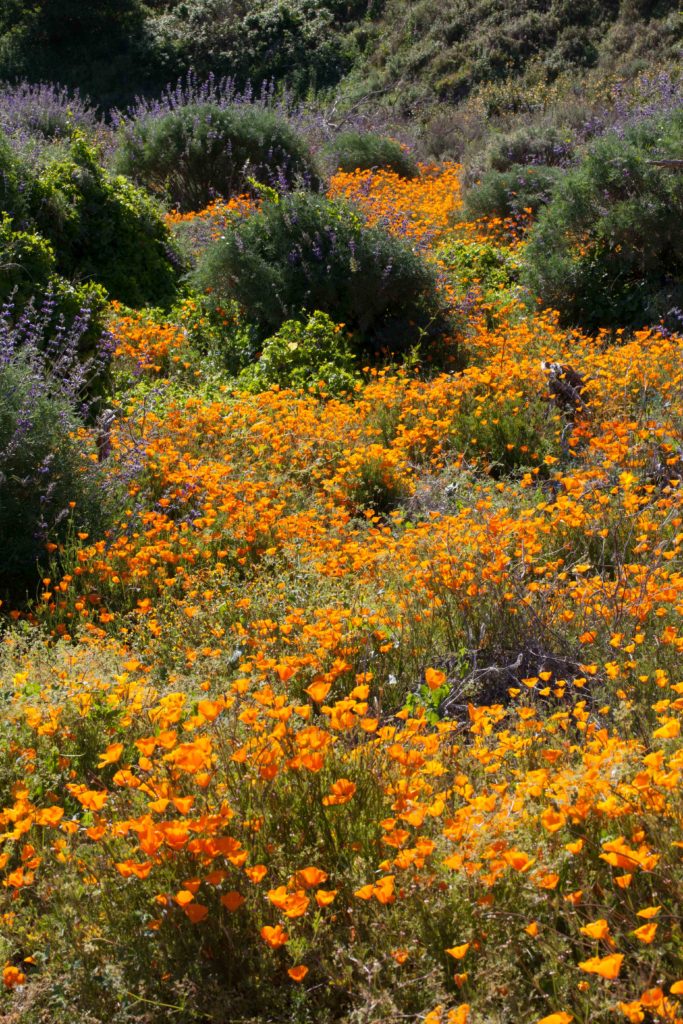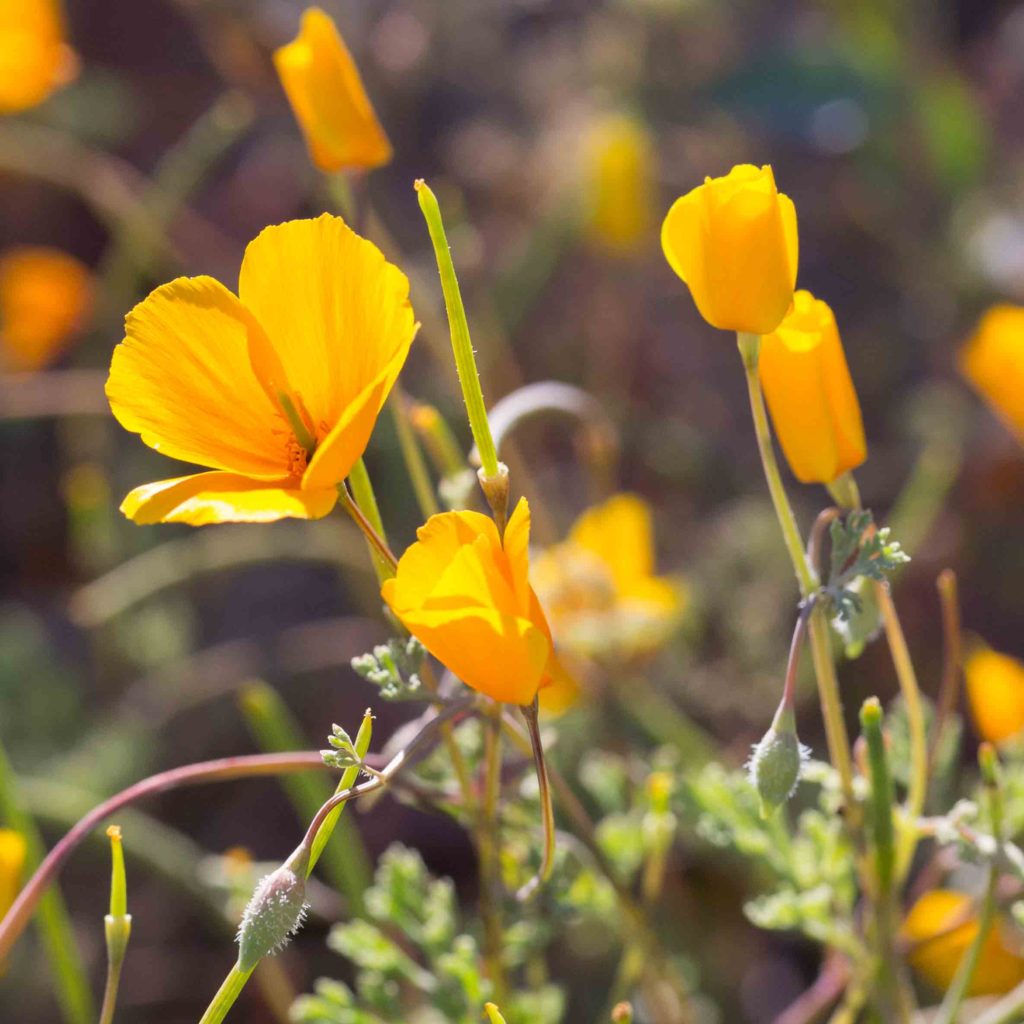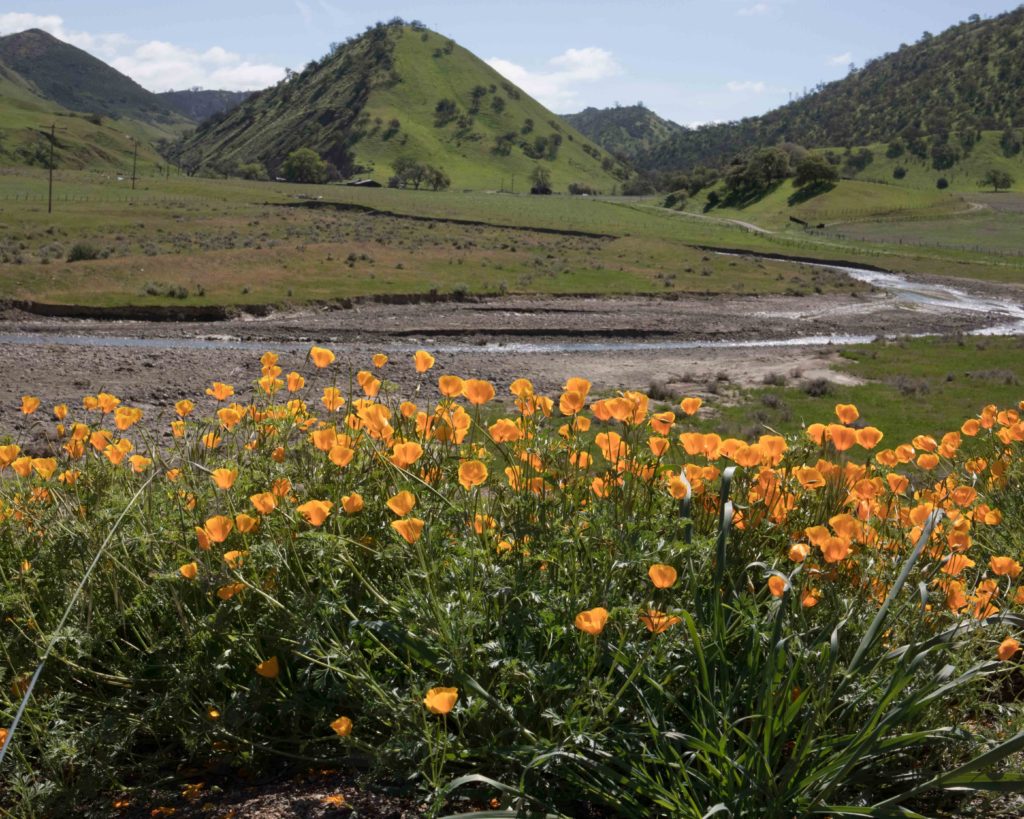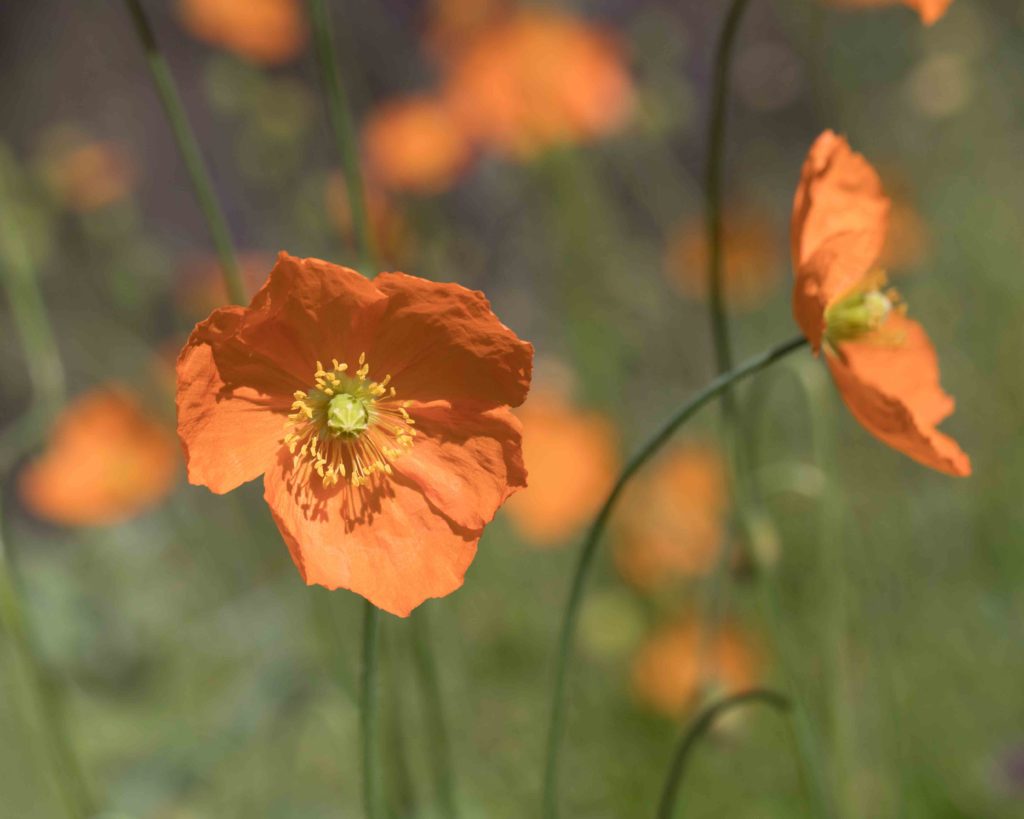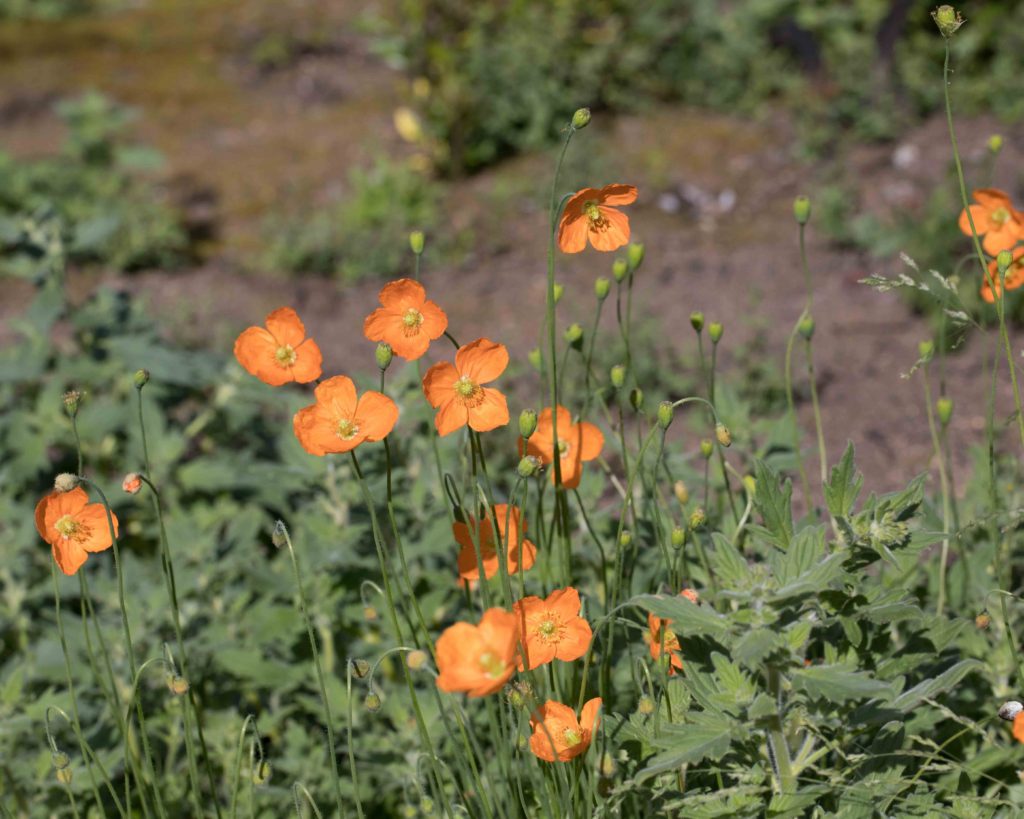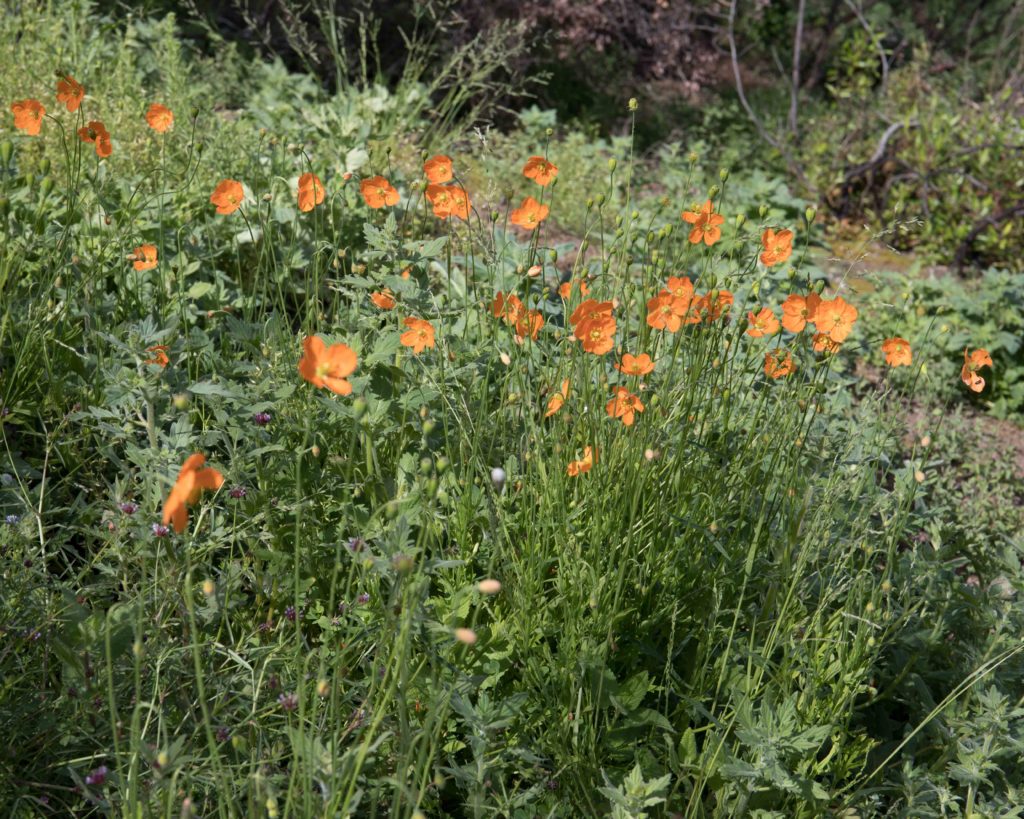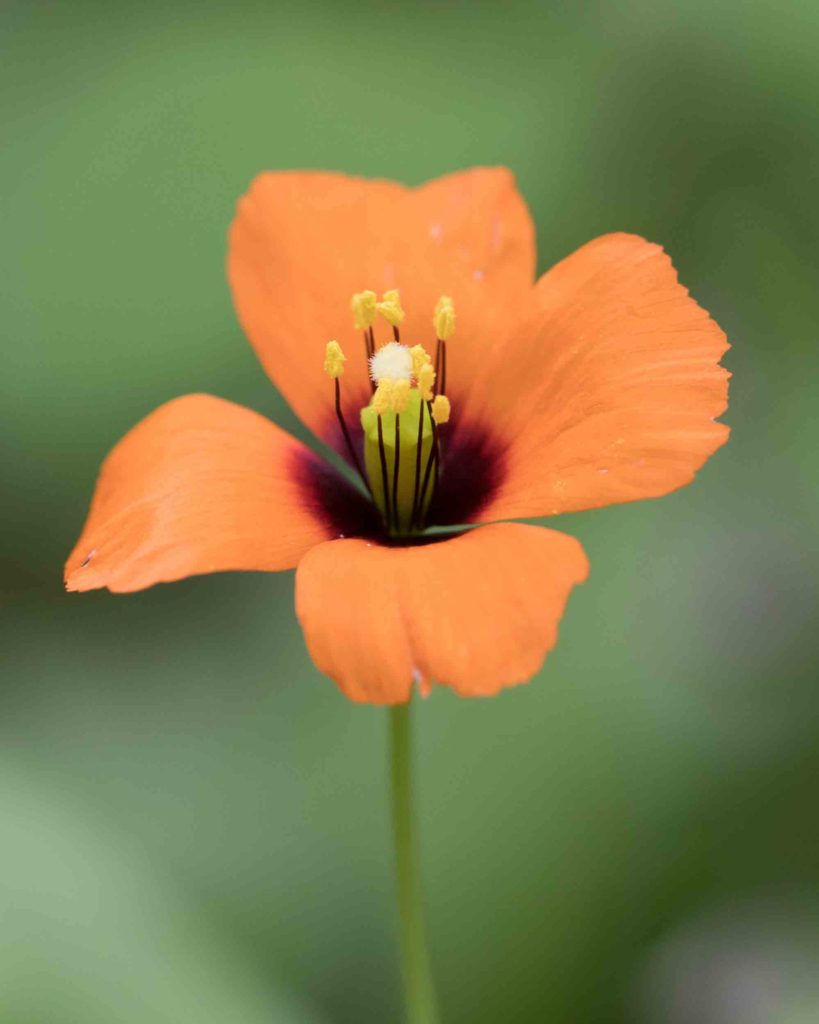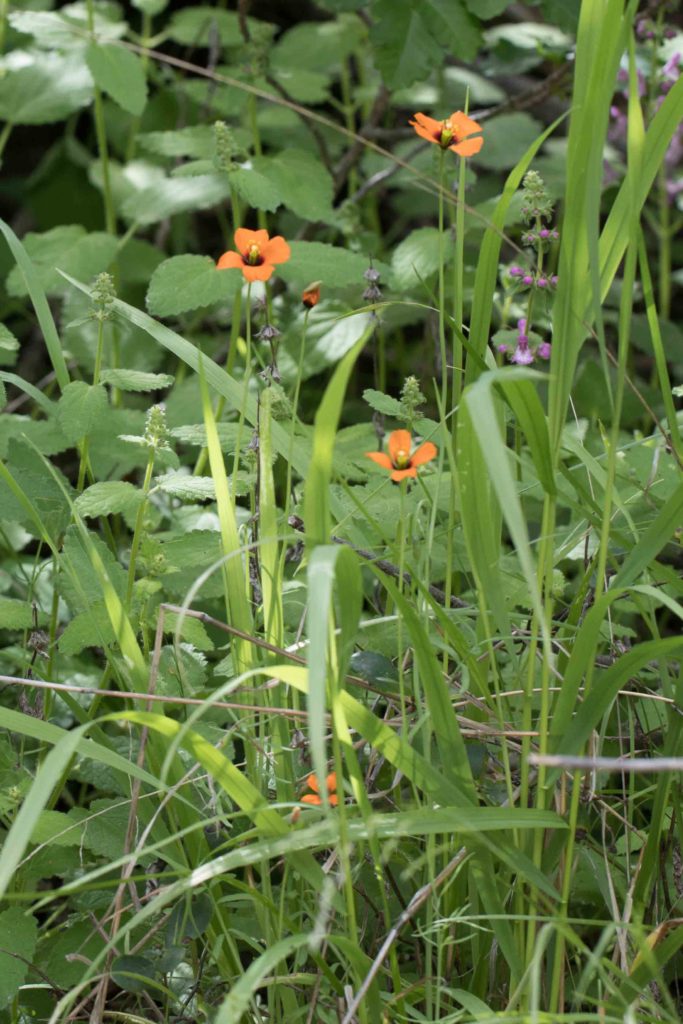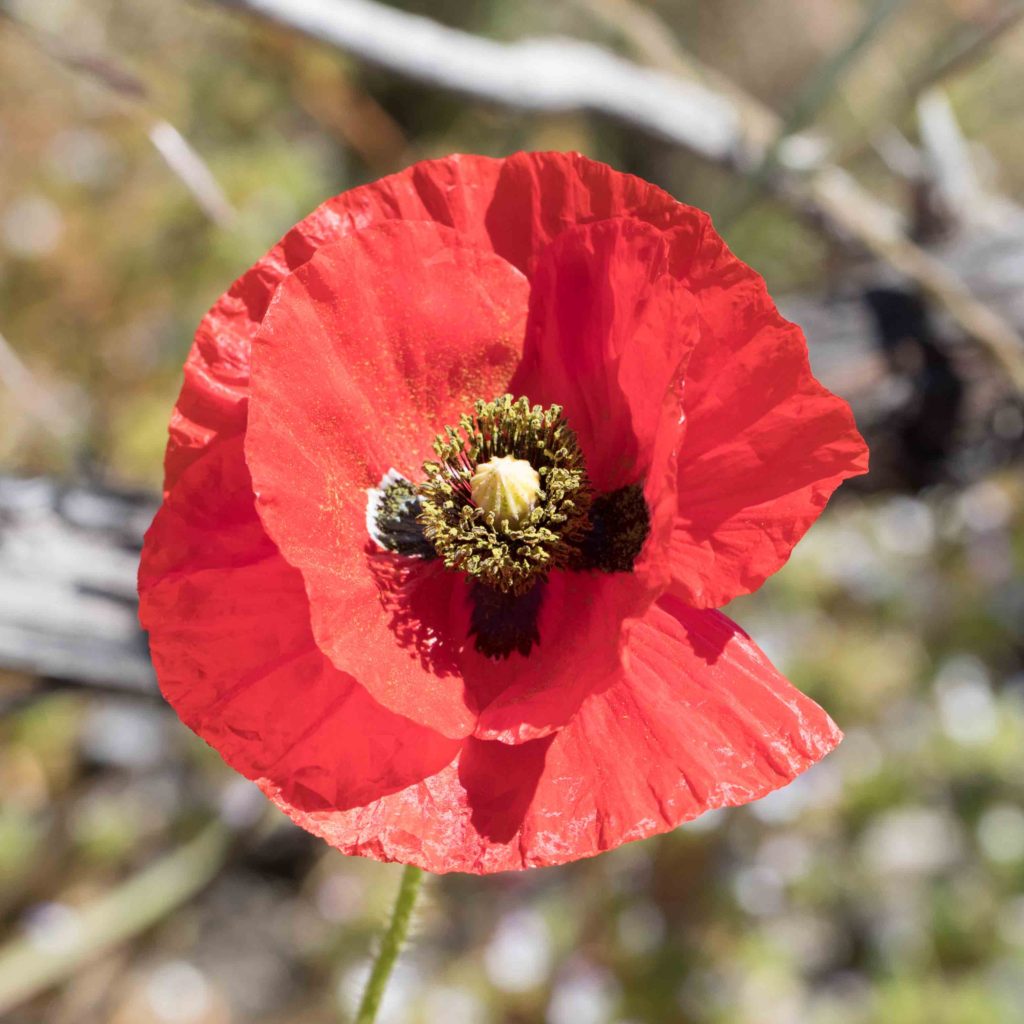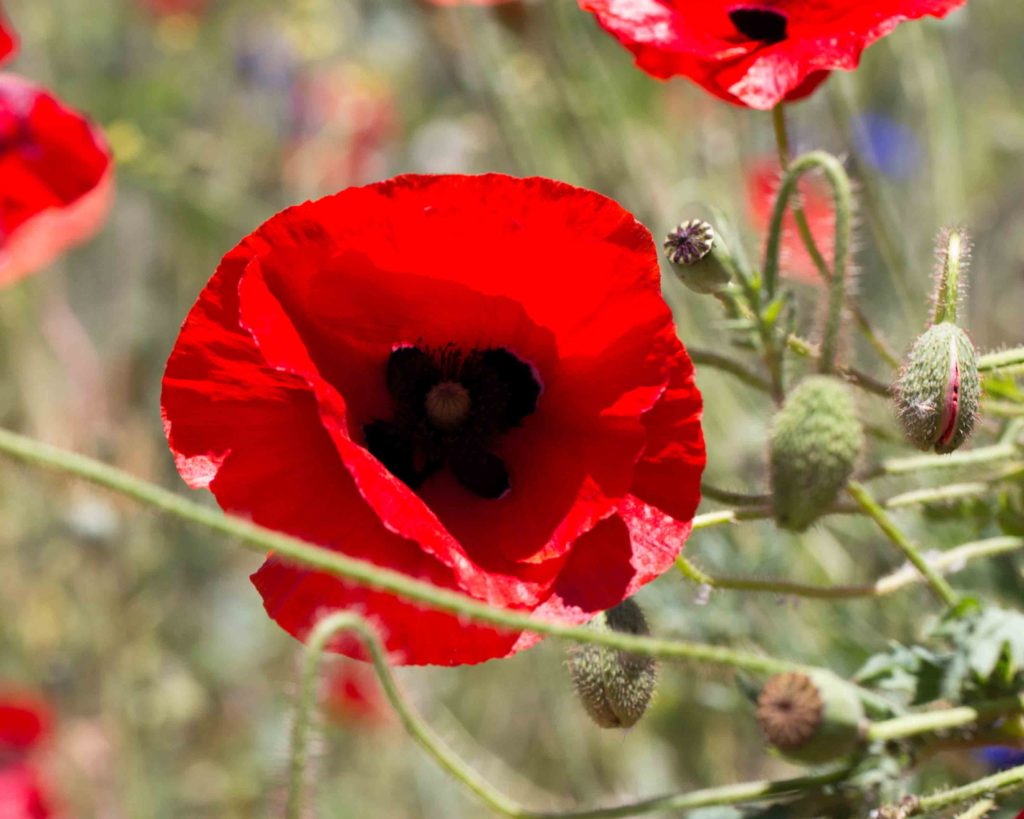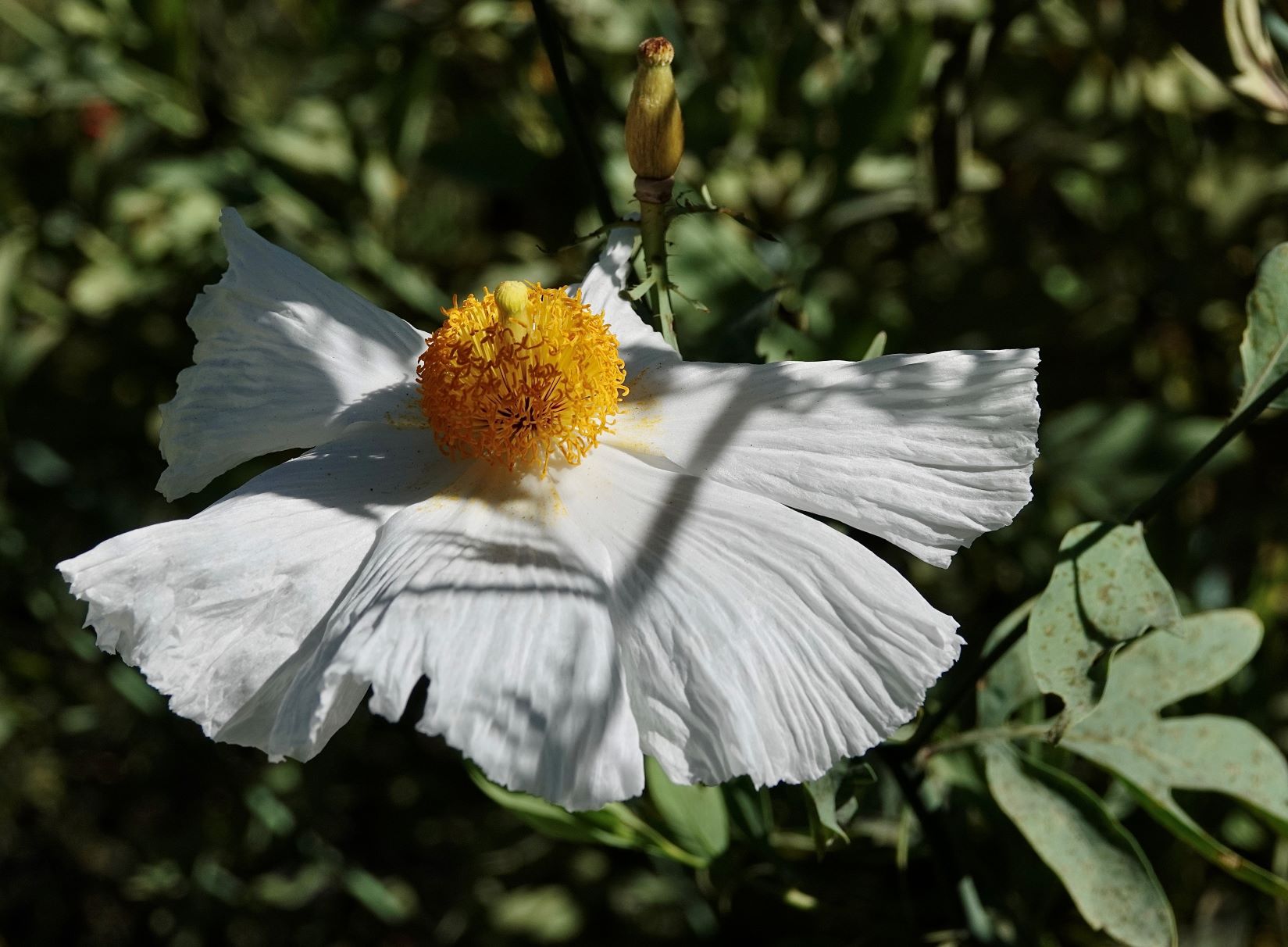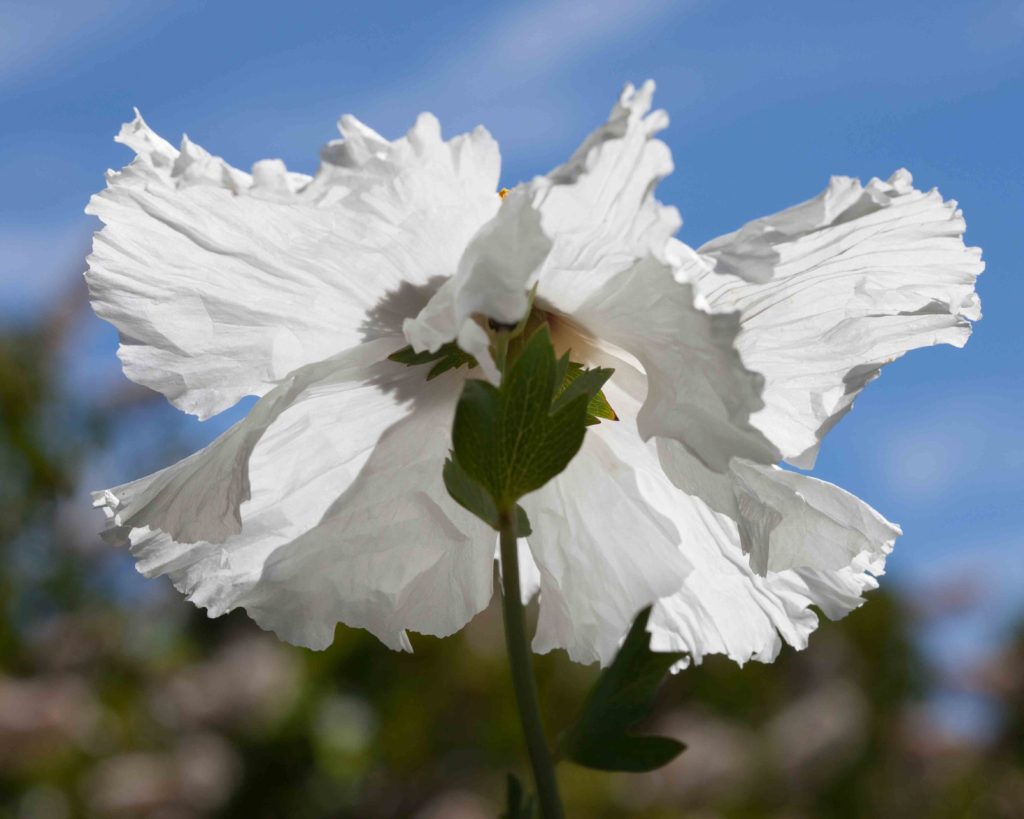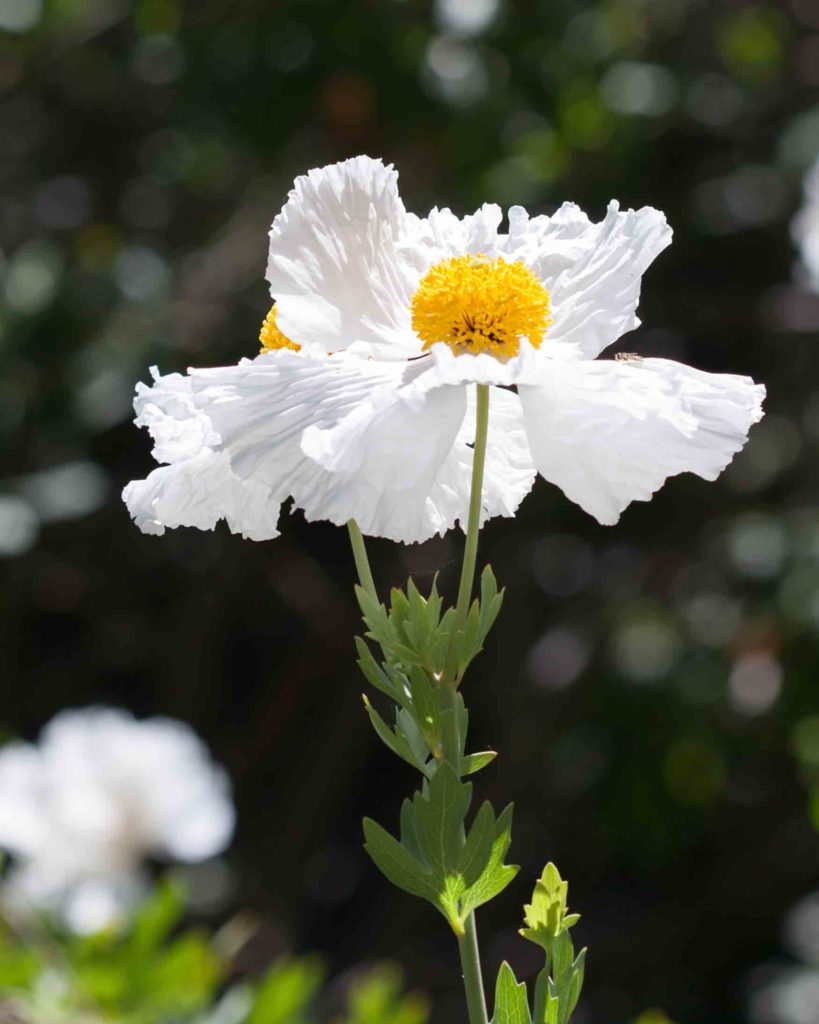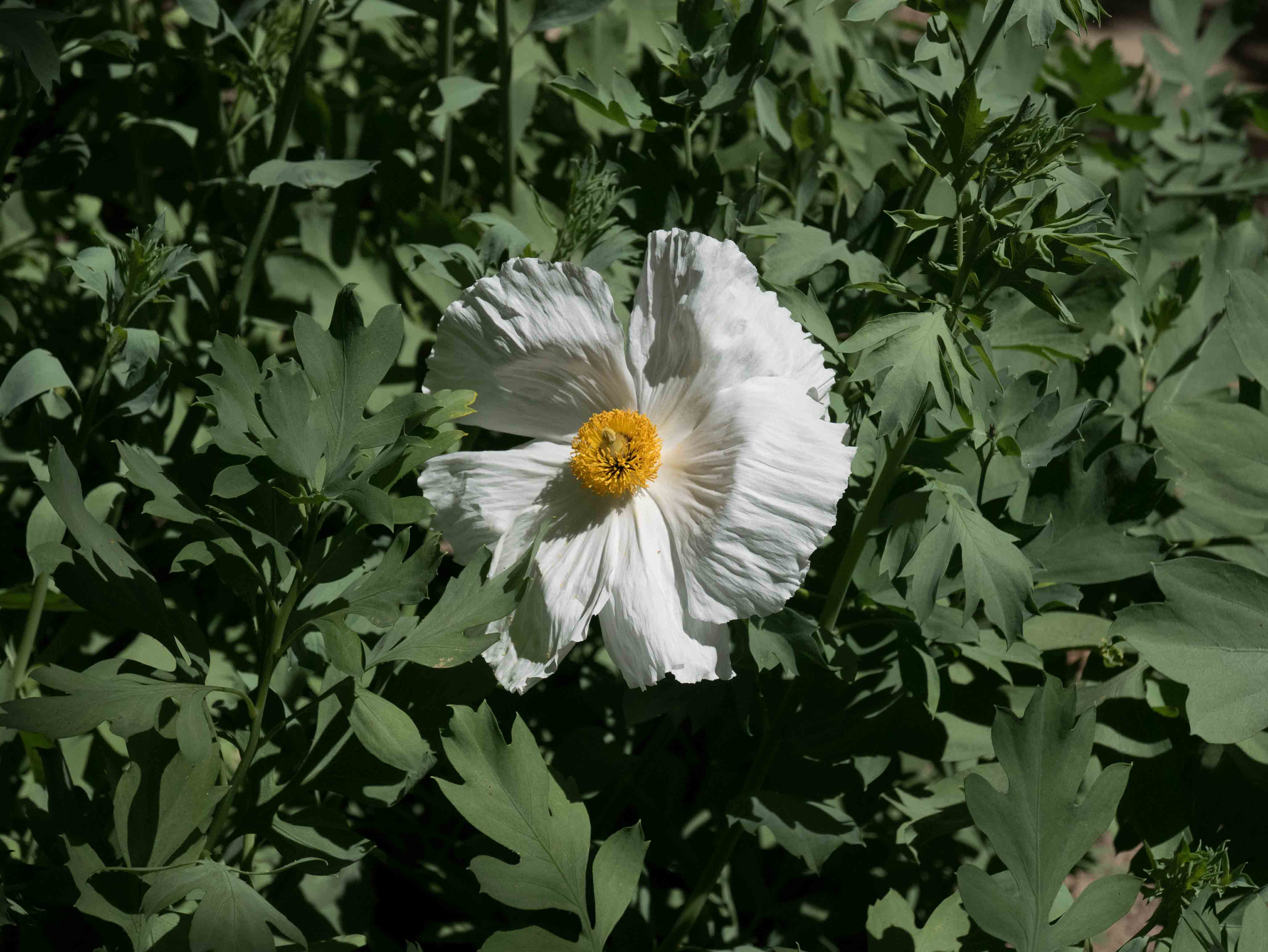Papaveraceae: Poppy Family — Poppies
This family has mostly regular, shallowly saucer-shaped flowers. There are usually 4 or 6 petals, and half that number of sepals. Sepals typically fall away when the flower opens. Five of the genera in this county are named “poppy”, and they are shown on this page. Eschscholzia, which includes the California Poppy, is the most common; the others are Papaver (which includes Fire and Wind Poppies), Argemone (Prickly Poppy), Dendromecon (Bush Poppy) and Romneya (the widely-cultivated Coulter’s Matilija Poppy).
Prickly Poppy / Chicalote – Argemone munita
Blooms:
May–Aug
Plant Height:
60–150 cm
Flower Size:
Large
Origin:
Native
Habitat:
Dry, disturbed places
Notes:
This an erect plant, with flowers similar to Coulter’s Matilija Poppy (Romneya coulteri, see below), though smaller (2.5–5 cm across) and more crinkled. The plant is covered throughout in stiff spines. The leaves are thistle-like and 5–15 cm long, quite different from those of Coulter’s Matilija Poppy.
Bush Poppy – Dendromecon rigida
Blooms:
Apr–June
Plant Height:
1–3 m
Flower Size:
Large
Origin:
Native
Habitat:
Dry slopes
Notes:
This is an open, leafy shrub. Its bowl-shaped flowers are immediately recognizable as poppies, with 4 petals (occasionally 6) and multiple stamens. Leaves are simple, up to 10 cm long and 2.5 cm wide. Photo #2 by CJH.
Tufted Poppy – Eschscholzia caespitosa
Blooms:
May–June
Plant Height:
5–30 cm
Flower Size:
Large
Origin:
Native
Habitat:
Dry flats and brushy slopes
Notes:
This is similar in appearance to California Poppy (Eschscholzia californica, see below). But the flowers are smaller, and the spreading disk-like rim at the base of the petals is either absent, or so small (< 0.3 mm) as to be virtually indiscernible. Flowers are yellow to yellowish-orange, occasionally with an orange-spotted base. The buds are erect and glabrous. The buds are an important point to note when comparing this species with San Benito Poppy (Eschscholzia hypecoides, see below), whose buds are nodding and generally hairy.
California Poppy – Eschscholzia californica
Blooms:
Feb–Sept
Plant Height:
5–60 cm
Flower Size:
Large
Origin:
Native
Habitat:
Grassy and open areas
Notes:
The state flower of California, this needs no comment except to differentiate it from other members of its genus. This species is distinctive in having a spreading, disk-like rim on the receptacle (immediately beneath the petals). This rim is 0.5–5 mm wide, while the other species have no rim or one that is less than 0.3 mm. The rim remains clearly visible at the base of the fruit. The flower color varies: it may be orange, yellow, or yellow-orange with an orange base. The leaves are finely dissected.
San Benito Poppy – Eschscholzia hypecoides
Blooms:
Mar–June
Plant Height:
5–30 cm
Flower Size:
Large
Origin:
Native
Rare or endangered?:
Yes – 4.3
Habitat:
Grassy areas in woodland & chaparral
Notes:
Similar in appearance to Tufted Poppy (Eschscholzia caespitosa, see above). The disk-like rim at the base of the petals is either absent or so small (< 0.3 mm) as to be virtually indiscernible. Flowers are yellow to yellowish-orange, occasionally with an orange-spotted base. The buds are nodding and generally hairy. This distinguishes them from Tufted Poppy, whose buds are erect and glabrous. The whole plant is sparsely hairy, unlike the other Eschscholzia found in the county. Found on the eastern slopes of the Santa Lucias and in the Inner Coast Ranges.
Fire Poppy – Papaver californicum
Blooms:
Apr–May
Plant Height:
20–60 cm
Flower Size:
Large
Origin:
Native
Habitat:
Burns
Notes:
As the common name suggests, this is a fire follower, generally found only in areas that have recently burned. It has 4 or 5 orange to brick-red petals, generally slightly wrinkled, with a greenish basal spot. There is no style, but the stigma is head-like (a characteristic of Papaver that differentiates them from Eschscholzia).
Wind Poppy – Papaver heterophyllum
Blooms:
Apr–May
Plant Height:
40–60 cm
Flower Size:
Large
Origin:
Native
Habitat:
Grassy or brushy slopes
Notes:
This delicate poppy has a single flower, with orange petals and a deep purple base. The stamens have red-purple filaments and yellow anthers. Note the short, fuzzy style and the prominent head-like stigma. Uncommon.
Corn Poppy – Papaver rhoeas
Blooms:
June–July
Plant Height:
30–80 cm
Flower Size:
Large
Origin:
Eurasia
Habitat:
Cultivated, occasional escape
Notes:
This poppy is unmistakable, with its vivid red flowers, often with a white-rimmed black spot at their base. Widely cultivated and occasionally escaping, it is unclear whether the species has actually become naturalized in California. This poppy is very common in Europe, and it flourished in the disturbed ground between the trenches in the First World War — leading to its adoption as the symbol of remembrance for those killed during the war.
Coulter’s Matilija Poppy – Romneya coulteri
Blooms:
Mar–July
Plant Height:
1–2.5 m
Flower Size:
Large
Origin:
Native (Santa Barbara County)
Habitat:
Widely cultivated, occasional garden escape
Notes:
This spectacular poppy is a large shrub or sub-shrub with gray-green, glaucous, deeply cut leaves. The flowers are the largest of any plant native to California (6–10 cm across). They have pure white, wrinkled petals, and many bright yellow stamens. It cannot be mistaken for anything else, except possibly for Prickly Poppy (Argemone munita, see above), which has smaller flowers and different leaves. Photo #1 by CJH.
